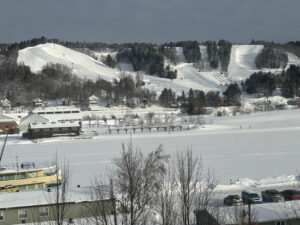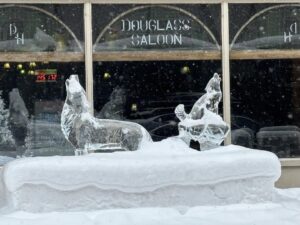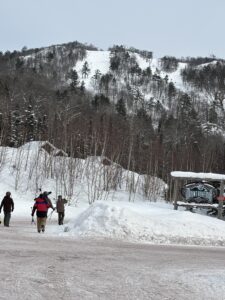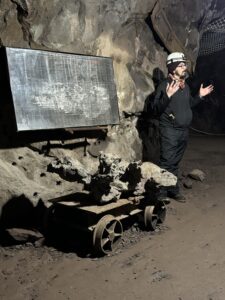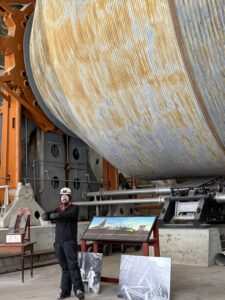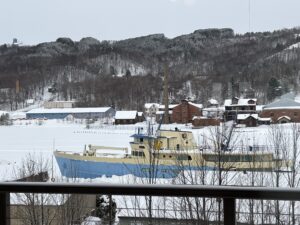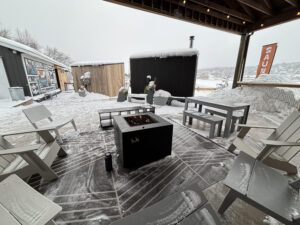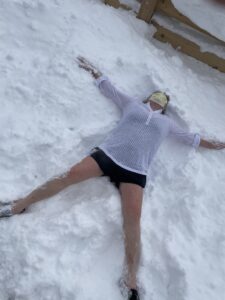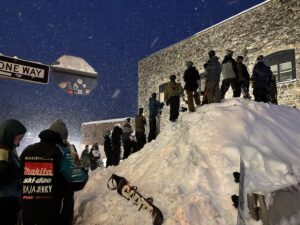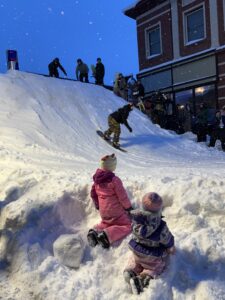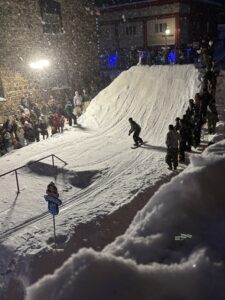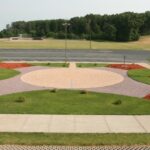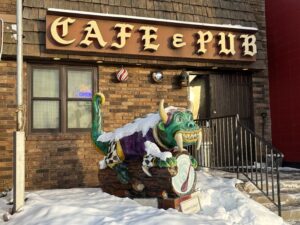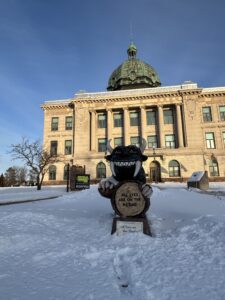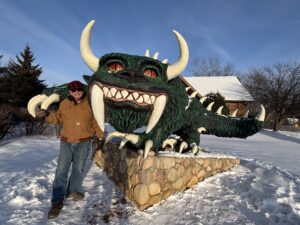Keweenaw Peninsula By Winter
Quincy Warmth
After a short walk through deep snow in the bitter cold, we entered a dimly lit tunnel. As we stepped into Quincy Mine’s long tunnel we were surrounded by warmth. Well, the warmth was relative. Outside it was below zero but inside the tunnel was a balmy 43 degrees.
We visited Quincy Mine in Michigan’s Keweenaw Peninsula in frigid February, but if we had been there on a blistering hot August day the mine’s interior temperature would be a delightfully cool 43 degrees. It’s always that temperature in that tunnel deep underground.
No matter the season, the Keweenaw Peninsula is a fun place to visit. It juts upward into Lake Superior. Lake effect snow piles deeply each winter, but in summer the Lake sends cool breezes inland.
“We Do Winter Well”
This claim by Visit Keweenaw advocates is no exaggeration. Residents navigate steep, snowy streets with aplomb. Some travel by snowmobiles to work, take a short spin during lunch breaks, and motor on home after work. They dress warmly and relish the cold. The area welcomes winter visitors who enjoy downhill and cross-country skiing, snowshoeing, snowmobiling, shopping, and meals of grilled lake whitefish and locally made pasties. More about them later. Broom and ice hockey regionally and at the Michigan Technological University draw in families by the dozens. The Huskies, sometimes known as the “Stick Huskies” – think hockey – compete, creating fabulous ice sculptures that dot the campus and area.
- Trail groomers started before dawn to groom trils.
- ice sculptures dot the town and campus.
- BoHo is an ungroomed Black Diamond ski area.
Shopping and dining are equally fun in summer, and warmer weather offers boating, swimming, fishing, and sightseeing. During warm months, visitors can book a ride on boats taking them to the distant Isle Royale National Park.
What and Where Is the Keweenaw?
The Keweenaw is actually a peninsula on a peninsula. It’s attached to the relatively wild Upper Peninsula, but interestingly it’s no longer a peninsula at all. Originally a natural inlet extended most of the way across the peninsula’s base. To facilitate shipping, land was removed, extending the inlet into a canal and making the Keweenaw an island. Today the main towns of Houghton and Hancock face each other across the Portage Canal and are separated by one of the world’s largest lift bridges. In summer, dozens of boats motor by, including some large ones.
Copper Country
For us touring Quincy Mine was a visit highlight. For nearly a century it produced thousands of tons of copper that helped America electrify. Quincy is only one of several that once operated in the area but they all were abandoned when less expensive, open pit mining got established in Utah.
Today Quincy Mine welcomes people to tour its towering surface features that pulled ore up from upwards of 9,000 feet underground. Down that far, the temperatures were blistering 80+ degrees. It was amazing, but we were more fascinated deep down in a mine tunnel when our guide, Clayton Gomez, stopped our small group and doused the electric lights, leaving only one candle to illuminate the vast darkness. “This is how much light miners had as they used muscles to drill into the rock.”
“They’d then stuff blasting power into the hole and set it off. Afterward they loaded the loose stone in carts and pushed it to a shaft where a lift carried it to the surface. It was dangerous and hard work. They earned $2 for a 10-hour shift,” he added. Some of us tried to muscle the heavy cart to little avail.
Initially, the demand was for highly skilled workers in teams of three. One held an iron bar, two alternated hitting the end. In between the one holding the bar, turned it slightly so it would not lodge in the rock. At best this would be dangerous. Done by candle light, required cooperation and skills. Mining innovations changed that. Men worked alone so if an accident happened, they might not be found for hours.
Clayton ended our tour with this thought: “Holes in the ground all we have left to tell the story.” But, he pointed out, copper remains such an important part of our lives. Computers, cars, cell phones.
- Clayton and mine shaft diagram.
- Mine shaft drum.
- Canal. Park Service Boat. Ski run. Quincy Mine Shaft on far hill.
Who Were the Early Settlers and Miners?
The workers, immigrants from the Cornish region, were small, tough, wiry. In the paternalist setting where they received housing and a few amenities, if one got injured or killed, the family was forced to move. After a sweat-soaking shift, the men would change into clothes and step into the sub-freezing weather and trundle home. Only to repeat the process the next day.
Other immigrants from northern Europe arrived and took to the cold, snowy climate. Today skiing and ski jumping are hallmarks of the Nordic heritage. Evidence of the Daughters of Italy, Sons of Norway, Canadian, Finnish and Cornish ancestry highlight the area.
Although mining is now long gone, a delicious traditional food remains. A meat and vegetable pie called a pasty is tasty, nutritious, and portable. (Say the word with a short “a” so as not to confuse with an accoutrement of pole dancers.) Miners would bring this traditional Cornish meal with them as they descended into the pit and enjoy it for lunch.
Many local stores and cafes now sell pasties and we ate several during our stay.
We also enjoyed taking a sauna at Takka Saunas on a frigid day. After sitting in a steamy small sauna building, we dashed out. Marion did the traditional Finnish tradition of laying down in the snow making a snow angel. Rich only stood barefoot in the snow. A sauna part of Finnish culture is fun in any season.
- Amenities abound
- Roll in the snow or plunge into cold water.
Keweenaw Mountain Lodge
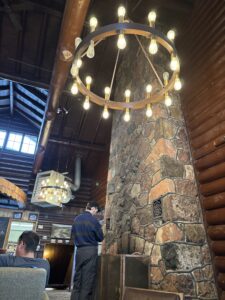
Dark sky and slow travel haven.
Part of our adventure was finding respite at the Keweenaw Mountain Lodge. Some in our group snowshoed. Others lounged in the rustic ambiance. Adjusting to “slow travel” and learning more about the dark sky options. As the lodge owner stated, “We lean into what is authentic and unique.” Heated cabins and groomed trails beckoned. The chef creates delicious picnic baskets and the Tasting Post features a “slow dining” experience. On clear nights the aurora is spectacular.
Jibba Jabba
We went to the Keweenaw for the annual Jibba Jabba Railjam. Dozens of young competitors climbed the manufactured hill in downtown Houghton and took turns sluicing down the steep slope, riding rails, swooshing through the tunnel, and spinning to a stop in front of hundreds of enthusiastic spectators. For days ahead, city crews had hauled in and packed snow at just the right angle on one of the steep streets that are hallmarks of Houghton. The result? Fast speed and thrilling rides down the course.
- Snowy wait
- Excitement
- Snowy event
Getting There
Five hundred miles north and slightly East is the thumb of the Keweenaw that juts into Lake Superior. Houghton, MI, is Eastern time so we lost an hour. We took two days going, stopping to walk a special labyrinth in Westfield, WI, and overnight at Rhinelander, taking in the Hodag Hunt. These mythological creatures frequent the town and purportedly the nearby forests. We did encounter several in town, which was fun. Eagle River is worth a stop with a terrific coffee shop and amazing annual ice sculptures.
- The Labyrinth we built as Andy’s Memorial.
- Special labyrinth
After two hours of snowy and scary driving we found clear pavement. Good thing we have advances in car technology and road safety. We stayed on our side of the road because of the center and side rumble strips. No “good ‘ole days” for us. We prefer safe cars and roadways.
We drove back in an easy day as we gained an hour.
- Welcome!
- Hodag hunt
- A beaten path to the visitor center Hodag.
For information on what to do at the Keweenaw and where to stay check out Visit Keweenaw.
We were there during winter’s icy grip but a future visit during summer’s warmth is in our plans.

